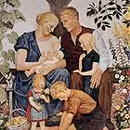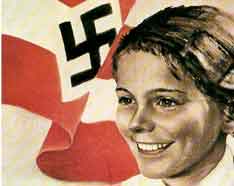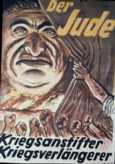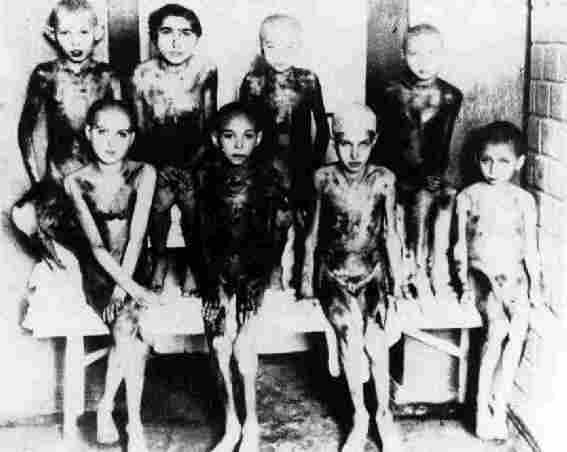|
|
|
|
For Hitler and the Nazis, Nazi rule involved the re-making of German society into a Volksgemeinschaft – a 'people's community' based on race, proper behaviour and Nazi principles. If not embraced willingly, this society would be imposed by force. It would be ordered around an Aryan Herrenklasse ('master race'), and would exclude anyone considered racially, biologically, politically, or socially unacceptable: 'There will be a Herrenklasse', he said, 'an historical class tempered by battle, and welded from the most varied elements. There will be a great hierarchy of party members; they will be the new middle class. And there will he the great mass of the anonymous, the serving collective. Nor will their financial or previous social position be of the slightest importance. These preposterous differences will have been liquidated in a single revolutionary process. But beneath them there will still be the class of subject alien races; we need not hesitate to call them the modern slave class. And over all of these will stand the new high aristocracy, the most deserving and the most responsible Fuhrer-personalities.' Hermannn Rauschning (1939), decribing 'table-talk'comments by Hitler
You need to be careful with this source. Originally a Nazi supporter,
Rauschning fell out of favour and fled to America,
|
Going DeeperThe following links will help you widen your knowledge: Simple pages from my KS3 series
Nazi Culture - excellent notes from Save My Exams
Podcasts
YouTube Hitler's Germany - BBC 20thC History Life in Nazi Germany - excellent History File video. Pete Jackson on how lives changed under the Nazis
|
How did Nazi rule affect Germans? [NOW YOU]The key here is to understand that the Nazi state affected different people in different ways. For the majority of people, in fact, life was good – that is why they turned a blind eye to the fact that – for groups which were not accepted by the Nazi state – life was horrific.
1. Nazi Party members
|
Source AFrom 1933 onwards, the German people clearly conformed with the Nazi regime and became devoted to Hitler. Hundreds of thousands of Germans from different classes joined the Nazi Party. In fact, so many people tried to join in 1933 that the Party struggled to cope with the numbers. In the years 1933–39, the Nazi Party gained four million new members. A flood of people also joined other Nazi organisations. The increase in support for the Nazis suggests that the majority of the German people found it easy to support the Nazi dictatorship. From Backing Hitler: Consent and Coercion in Nazi Germany by R Gellately, published in 2001.
Source BWe all felt the same, the same happiness and joy. Things were looking up. I believe no statesman has ever been as loved as Adolf Hitler was then. It’s all come flooding back to me. Those were happy times. A German farmer, Luise Essig, remembering life in Nazi Germany.
|
2. Ordinary peopleFor ordinary people, life was good, and many Germans even today look back and remember the years before 1939 as happy years:
There were some drawbacks:
|
|
3. WomenSource CHitler was very clear that women should bring up children at home while their husbands worked. Schools taught girls from a young age that all good German women should get married and have children. 800,000 couples accepted loans offered as part of the Law for the Encouragement of Marriage. Women were not expected to work in Nazi Germany. Within months of Hitler coming to power, many female doctors and civil servants were sacked, followed by female teachers and lawyers. By 1939, very few women were in full-time work. From The History Learning Site, a history website.
The Nazis aimed to align women’s identity and activities with the regime’s racial and ideological goals. Nazi philosophy held up women as vital to Germany’s national regeneration into the Volksgemeinschaft – the bearers of Aryan children and defenders of the traditional family values. They sought to attract working-class and lower-middle-class women through promises of social stability, support for large families and, above all, adoration of Hitler:
But at the same time the Nazis were very male-dominated and anti-feminist:
Not all women were happy with the Nazi regime, but few women openly opposed it.
|
BBC Bitesize on Nazi policies towards women
The perfect Nazi family.
|
4. YouthMost German young people were happy:
But not all young people were happy with the Nazi regime:
|
BBC Bitesize on Nazi policies towards the young Hitler Youth in Nazi Germany – YouTube More sources on Nazi youth
The perfect Nazi boy ... and Aryan girl.
Edelweiss Pirate Barthel Schink, 17, wearing his edelweiss flower badge.
|
5. OpponentsThe Nazis used 'fear and horror' against anyone who disapproved of their regime:
But remember that:
|
BBC Bitesize on Opposition and resistance Nazi concentration camp badges
|
6. UntermenschThe Nazi regime despised many groups which it thought were racially or socially inferior (Untermensch = subhuman) – people they called the 'germs of destruction'. A main architect and enforcer of the Nazi's racial theories was Heinrich Himmler. Many Germans approved of this racism, or turned a 'blind eye'.
The Nazi regime was from the start based on anti-semitism:
Other groups which were persecuted and killed included:
The Nazis believed in 'eugenics' – that it was possible to eliminate certain disabilities by preventing those people from having children:
|
BBC Bitesize on the persecution of minorities The persecution of the Jews - essential link
YouTube Pete Jackson on Society under the Nazis, focussing on Nazi racial policies
A Nazi race-hatred poster: "The Jew - the inciter of war, the prolonger of war".
Using negative images and stereotypes - such as this illustration from The Poisonous Mushroom - Nazi propaganda pilloried Jews as dirty, deceitful, dangerous people of whom Germany should be free.
Children in concentration camps who had been used for medical experiments.
|
|
|
|
|
Spotted an error on this page? Broken link? Anything missing? Let me know. |
|





